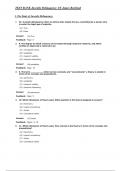Exam (elaborations)
Test Bank Juvenile Delinquency, 3rd Edition by James Burfeind.
- Course
- Institution
Test Bank For Juvenile Delinquency, 3rd Edition by James Burfeind, Dawn Jeglum Bartusch. ISBN13: 9781138843202. Burfeind 3e test bank for Juvenile Delinquency.
[Show more]



